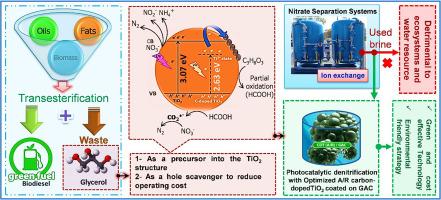An efficient and cost-effective advanced reduction process for nitrate removal from various real saline waters using carbon-doped TiO2
IF 7.7
Q2 ENGINEERING, ENVIRONMENTAL
引用次数: 0
Abstract
To meet the Sustainable Development Goals, NO3- must be removed from drinking water. NO3- is removed using IX technology, but waste disposal and the significant amount of NaCl required to make fresh brine have become problems for the economy and the environment. This work utilized an innovative, economical, and eco-friendly photocatalytic denitrification (PD) under visible light exposure for treating and reuse of IX brine waste (IXWB) using glycerol. FESEM-EDX, XRD, BET, FTIR, elemental mapping, and UV-Vis absorption spectra were used for physicochemical characteristics of carbon-doped TiO2 (CT) nanocomposite. CCD-RSM was utilized for the experimental design and process optimization. With increasing calcination temperature, anatase transformed to rutile, resulting in larger particle sizes/ crystallites and narrower optical band gaps. Additionally, the band gap decreased from 2.98 to 2.58 eV after carbon doping. Under ideal conditions with a mixed A (55 %)/R (45 %) phase of CT sample, the highest PD efficiency was resulted 94 % and 68 % with formic acid and glycerol, respectively. The application of glycerol as an economic hole scavenger for two actual brines provided a NO3- reduction of almost 95 %. The optimized CT sample on the surface of GAC was still stable and active after seven cycles with 18.02 US$/ m3 operating cost.

采用掺杂碳的二氧化钛制备了一种高效、经济的高级还原工艺,用于去除各种真实咸水中的硝酸盐
为了实现可持续发展目标,必须从饮用水中去除NO3-。使用IX技术去除NO3-,但废物处理和制备新鲜盐水所需的大量NaCl已成为经济和环境问题。本研究利用一种创新、经济、环保的光催化脱氮(PD)技术,在可见光下使用甘油处理和再利用IX盐水废物(IXWB)。利用FESEM-EDX、XRD、BET、FTIR、元素映射、UV-Vis吸收光谱等分析了碳掺杂TiO2 (CT)纳米复合材料的理化性质。利用CCD-RSM进行了实验设计和工艺优化。随着煅烧温度的升高,锐钛矿转变为金红石,晶粒尺寸增大,光学带隙变窄。碳掺杂后,带隙从2.98 eV减小到2.58 eV。在理想条件下,CT样品的a (55%)/R(45%)相混合,甲酸和甘油的PD效率最高,分别为94%和68%。将甘油作为两种实际卤水的经济孔洞清除剂,可使NO3-减少近95%。优化后的CT样品在GAC表面经过7次循环后仍保持稳定和活性,运行成本为18.02美元/ m3。
本文章由计算机程序翻译,如有差异,请以英文原文为准。
求助全文
约1分钟内获得全文
求助全文
来源期刊

Journal of hazardous materials advances
Environmental Engineering
CiteScore
4.80
自引率
0.00%
发文量
0
审稿时长
50 days
 求助内容:
求助内容: 应助结果提醒方式:
应助结果提醒方式:


